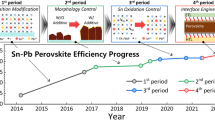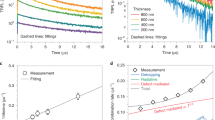Abstract
Herein, we for the first time doped Nb5+ into the low-temperature (<100°C) SnO2 sol-gel route to tailor the electrical property of SnO2 layers and the band alignment between SnO2 and the normally used mixed perovskites. The results revealed that proper Nb5+ do** increased the conductivity of the SnO2 electron transport layer (ETL), and the conduction band (CB) level of the SnO2 ETL was shifted down to approach the CB level of perovskites, which facilitated the electron injection from perovskite to SnO2, accelerated the charge transport, and reduced the non-radiative recombination, leading to improved power conversion efficiency from 18.06% to 19.38%. The Nb5+ do** process provided an efficient route for fabricating high-efficiency perovskite solar cells (PSCs) at a temperature lower than 100°C, and promoted the commercialization progress of PSCs.
摘要
本文中我们首次在低温(<100°C)SnO2溶胶-凝胶中通过掺杂Nb5+调控SnO2电学性质, 使SnO2与混合离子钙钛矿之间形成更匹配的能级. 掺杂Nb5+后SnO2电子传输层导电率明显提升, 导带位置下移更加接**混合离子钙钛矿导带, 有效促进了电子由SnO2向钙钛矿层的注入, 并加速了电子传输过程, 二者的共同作用使非辐射复合几率降低, 器件效率由18.06%提升至19.38%. Nb5+掺杂SnO2为低温(<100°C)制备高效率钙钛矿太阳能电池提供了有效参考途径, 有望进一步推动钙钛矿太阳能电池的产业化进程.
Similar content being viewed by others
References
Correa-Baena JP, Abate A, Saliba M, et al. The rapid evolution of highly efficient perovskite solar cells. Energy Environ Sci, 2017, 10: 710–727
Yun S, Qin Y, Uhl AR, et al. New-generation integrated devices based on dye-sensitized and perovskite solar cells. Energy Environ Sci, 2018, 11: 476–526
Peng J, Chen Y, Zheng K, et al. Insights into charge carrier dynamics in organo-metal halide perovskites: from neat films to solar cells. Chem Soc Rev, 2017, 46: 5714–5729
Polavarapu L, Nickel B, Feldmann J, et al. Advances in quantumconfined perovskite nanocrystals for optoelectronics. Adv Energy Mater, 2017, 7: 1700267
Wang H, Kim DH. Perovskite-based photodetectors: materials and devices. Chem Soc Rev, 2017, 46: 5204–5236
Wang S, Bi C, Yuan J, et al. Original core–shell structure of cubic CsPbBr3@amorphous CsPbBrx perovskite quantum dots with a high blue photoluminescence quantum yield of over 80%. ACS Energy Lett, 2018, 3: 245–251
https://doi.org/www.nrel.gov/pv/assets/images/efficiency-chart.png
Kim HS, Lee CR, Im JH, et al. Lead iodide perovskite sensitized allsolid-state submicron thin film mesoscopic solar cell with efficiency exceeding 9%. Sci Rep, 2012, 2: 591
Burschka J, Pellet N, Moon SJ, et al. Sequential deposition as a route to high-performance perovskite-sensitized solar cells. Nature, 2013, 499: 316–319
Liu M, Johnston MB, Snaith HJ. Efficient planar heterojunction perovskite solar cells by vapour deposition. Nature, 2013, 501: 395–398
Yang WS, Park BW, Jung EH, et al. Iodide management in formamidinium-lead-halide–based perovskite layers for efficient solar cells. Science, 2017, 356: 1376–1379
Snaith HJ, Abate A, Ball JM, et al. Anomalous hysteresis in perovskite solar cells. J Phys Chem Lett, 2014, 5: 1511–1515
Kim HS, Park NG. Parameters affectin. I–V hysteresis of CH3 NH3PbI3 perovskite solar cells: effects of perovskite crystal size and mesoporous TiO2 layer. J Phys Chem Lett, 2014, 5: 2927–2934
Unger EL, Hoke ET, Bailie CD, et al. Hysteresis and transient behavior in current–voltage measurements of hybrid-perovskite absorber solar cells. Energy Environ Sci, 2014, 7: 3690–3698
Chen HW, Sakai N, Ikegami M, et al. Emergence of hysteresis and transient ferroelectric response in organo-lead halide perovskite solar cells. J Phys Chem Lett, 2015, 6: 164–169
Leijtens T, Eperon GE, Pathak S, et al. Overcoming ultraviolet light instability of sensitized TiO2 with meso-superstructured organometal tri-halide perovskite solar cells. Nat Commun, 2013, 4: 2885
Guo X, Dong H, Li W, et al. Multifunctional MgO layer in perovskite solar cells. ChemPhysChem, 2015, 16: 1727–1732
Aristidou N, Sanchez-Molina I, Chotchuangchutchaval T, et al. The role of oxygen in the degradation of methylammonium lead trihalide perovskite photoactive layers. Angew Chem Int Ed, 2015, 54: 8208–8212
Snaith HJ, Ducati C. SnO2-based dye-sensitized hybrid solar cells exhibiting near unity absorbed photon-to-electron conversion efficiency. Nano Lett, 2010, 10: 1259–1265
Ke W, Fang G, Liu Q, et al. Low-temperature solution-processed tin oxide as an alternative electron transporting layer for efficient perovskite solar cells. J Am Chem Soc, 2015, 137: 6730–6733
Correa Baena JP, Steier L, Tress W, et al. Highly efficient planar perovskite solar cells through band alignment engineering. Energy Environ Sci, 2015, 8: 2928–2934
Dong Q, Wang M, Zhang Q, et al. Discontinuous SnO2 derived blended-interfacial-layer in mesoscopic perovskite solar cells: Minimizing electron transfer resistance and improving stability. Nano Energy, 2017, 38: 358–367
Dong Q, Xue Y, Wang S, et al. Rational design of SnO2-based electron transport layer in mesoscopic perovskite solar cells: more kinetically favorable than traditional double-layer architecture. Sci China Mater, 2017, 60: 963–976
Jiang Q, Zhang L, Wang H, et al. Enhanced electron extraction using SnO2 for high-efficiency planar-structure HC(NH2)2PbI3-based perovskite solar cells. Nat Energy, 2016, 2: 16177
Anaraki EH, Kermanpur A, Steier L, et al. Highly efficient and stable planar perovskite solar cells by solution-processed tin oxide. Energy Environ Sci, 2016, 9: 3128–3134
**e J, Huang K, Yu X, et al. Enhanced electronic properties of SnO2 via electron transfer from graphene quantum dots for efficient perovskite solar cells. ACS Nano, 2017, 11: 9176–9182
Dong Q, Shi Y, Zhang C, et al. Energetically favored formation of SnO2 nanocrystals as electron transfer layer in perovskite solar cells with high efficiency exceeding 19%. Nano Energy, 2017, 40: 336–344
Liu D, Li S, Zhang P, et al. Efficient planar heterojunction perovskite solar cells with Li-doped compact TiO2 layer. Nano Energy, 2017, 31: 462–468
Peng J, Duong T, Zhou X, et al. Efficient indium-doped TiOx electron transport layers for high-performance perovskite solar cells and perovskite-silicon tandems. Adv Energy Mater, 2017, 7: 1601768
Yang D, Yang R, Zhang J, et al. High efficiency flexible perovskite solar cells using superior low temperature TiO2. Energy Environ Sci, 2015, 8: 3208–3214
Gao XX, Ge QQ, Xue DJ, et al. Tuning the Fermi-level of TiO2 mesoporous layer by lanthanum do** towards efficient perovskite solar cells. Nanoscale, 2016, 8: 16881–16885
Ren X, Yang D, Yang Z, et al. Solution-processed Nb:SnO2 electron transport layer for efficient planar perovskite solar cells. ACS Appl Mater Interfaces, 2017, 9: 2421–2429
Halvani Anaraki E, Kermanpur A, Mayer MT, et al. Low-temperature Nb-doped SnO2 electron-selective contact yields over 20% efficiency in planar perovskite solar cells. ACS Energy Lett, 2018, 3: 773–778
**ong L, Qin M, Yang G, et al. Performance enhancement of high temperature SnO2-based planar perovskite solar cells: electrical characterization and understanding of the mechanism. J Mater Chem A, 2016, 4: 8374–8383
Yan J, Wu G, Guan N, et al. Nb2O5/TiO2 heterojunctions: Synthesis strategy and photocatalytic activity. Appl Catal B-Environ, 2014, 152-153: 280–288
Chen BX, Rao HS, Li WG, et al. Achieving high-performance planar perovskite solar cell with Nb-doped TiO2 compact layer by enhanced electron injection and efficient charge extraction. J Mater Chem A, 2016, 4: 5647–5653
Ruiz AM, Dezanneau G, Arbiol J, et al. Insights into the structural and chemical modifications of Nb additive on TiO2 Nanoparticles. Chem Mater, 2004, 16: 862–871
Sun SH, Meng GW, Zhang GX, et al. Raman scattering study of rutile SnO2 nanobelts synthesized by thermal evaporation of Sn powders. Chem Phys Lett, 2003, 376: 103–107
Jesper Jacobsson T, Correa-Baena JP, Pazoki M, et al. Exploration of the compositional space for mixed lead halogen perovskites for high efficiency solar cells. Energy Environ Sci, 2016, 9: 1706–1724
Obrzut J, Page KA. Electrical conductivity and relaxation in poly (3-hexylthiophene). Phys Rev B, 2009, 80: 195211
Yin G, Ma J, Jiang H, et al. Enhancing efficiency and stability of perovskite solar cells through Nb-do** of TiO2 at low temperature. ACS Appl Mater Interfaces, 2017, 9: 10752–10758
Wang Q, Shao Y, Dong Q, et al. Large fill-factor bilayer iodine perovskite solar cells fabricated by a low-temperature solutionprocess. Energy Environ Sci, 2014, 7: 2359–2365
Chen C, Liu D, Zhang B, et al. Carrier interfacial engineering by bismuth modification for efficient and thermoresistant perovskite solar cells. Adv Energy Mater, 2018, 354: 1703659
Acknowledgements
This work was supported by the National Natural Science Foundation of China (51273104 and 91433205).
Author information
Authors and Affiliations
Corresponding author
Additional information
**g Liu graduated from Bei**g University of Chemical Technology (BUCT) in 2016 with a bachelor’s degree. Currently, he is a postgraduate at Northeast Normal University, and receives united training at Tsinghua University. His research interest focuses on electron transport layers of perovskite solar cells.
Liduo Wang is a professor of the Department of Chemistry at Tsinghua University. He received his PhD degree from Nagoya University in 1995. Dr. Wang has once worked as a visiting scholar in the Department of Chemistry and as a research associate in the Department of Electrical and Electronic Engineering at Hong Kong University of Science and Technology, and as a postdoctoral researcher in the Department of Materials Science and Engineering, Tsinghua University. His current research interests include perovskite solar cells, organic-inorganic semiconductor multilayer and its optoelectronic properties.
Electronic supplementary material
Rights and permissions
About this article
Cite this article
Liu, J., Li, N., Dong, Q. et al. Tailoring electrical property of the low-temperature processed SnO2 for high-performance perovskite solar cells. Sci. China Mater. 62, 173–180 (2019). https://doi.org/10.1007/s40843-018-9305-6
Received:
Accepted:
Published:
Issue Date:
DOI: https://doi.org/10.1007/s40843-018-9305-6




